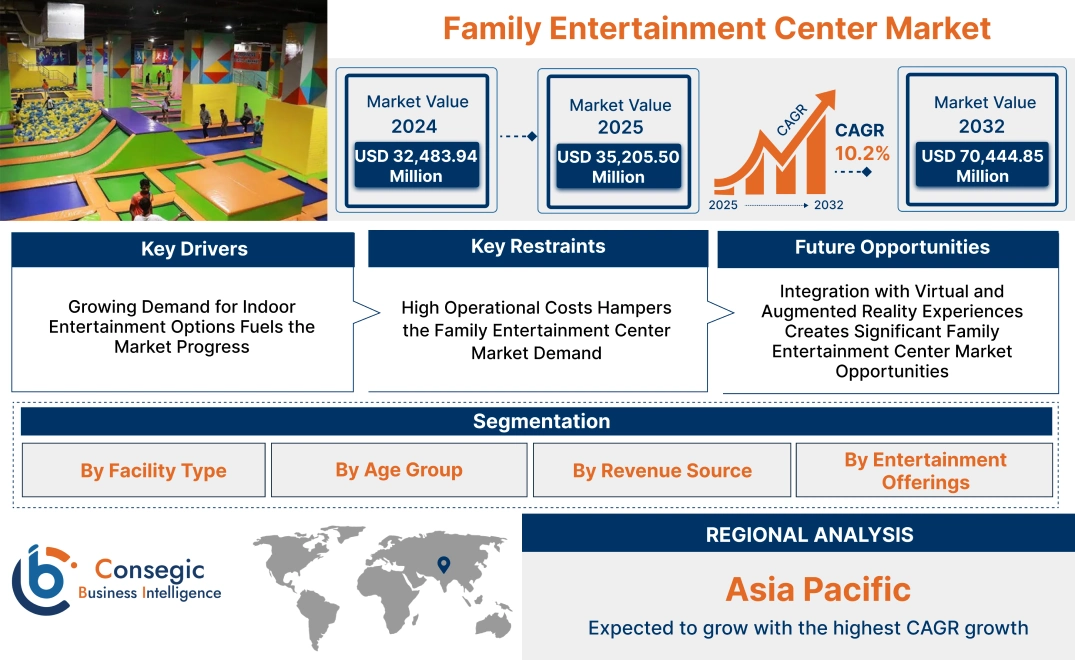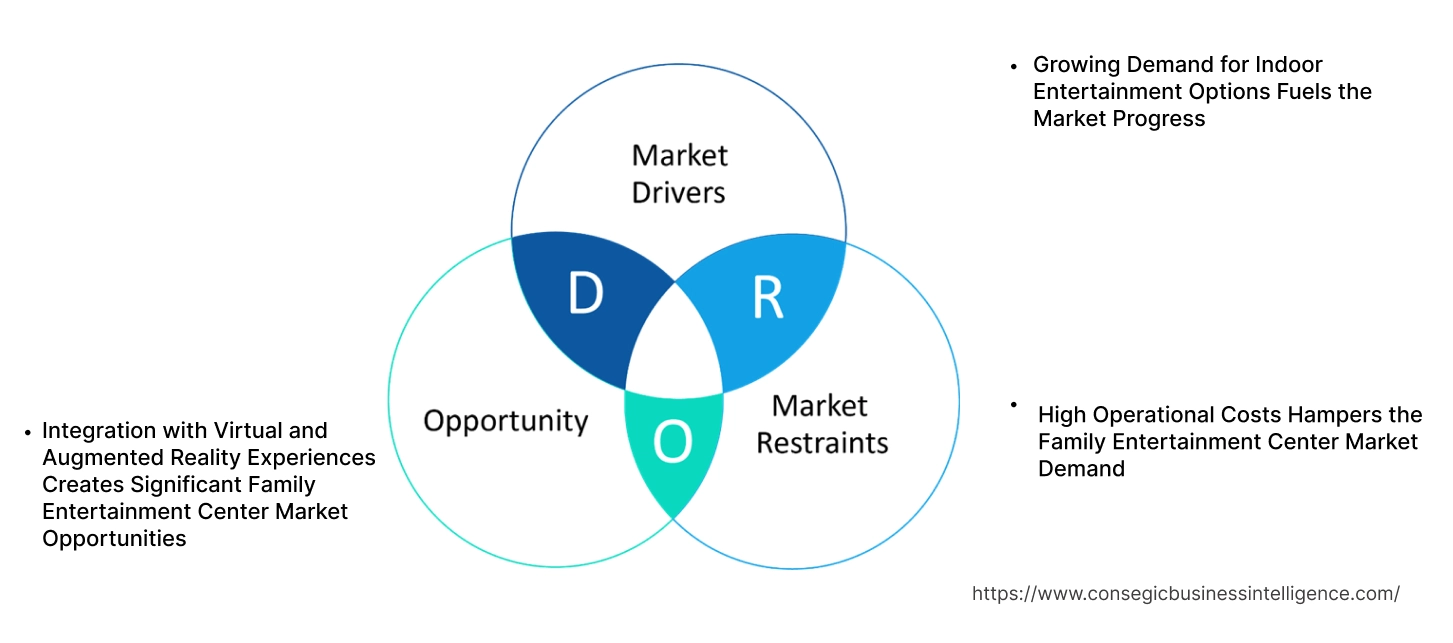- Summary
- Table Of Content
- Methodology
Family Entertainment Center Market Size:
Family Entertainment Center Market size is estimated to reach over USD 70,444.85 Million by 2032 from a value of USD 32,483.94 Million in 2024 and is projected to grow by USD 35,205.50 Million in 2025, growing at a CAGR of 10.2% from 2025 to 2032.
Family Entertainment Center Market Scope & Overview:
A family entertainment center (FEC) is a dedicated venue offering a variety of recreational and amusement activities designed to cater to individuals of all age groups, especially families. These centers typically feature a diverse range of attractions, including arcade games, bowling alleys, mini-golf courses, laser tag arenas, indoor playgrounds, and virtual reality experiences, creating an engaging environment for social interaction and entertainment.
FECs are designed to provide safe, accessible, and interactive spaces that encourage family bonding and group activities. They are often customized with themed entertainment zones and integrated food and beverage services to enhance the overall visitor experience. Additionally, these centers are equipped with advanced gaming technologies and modern facilities to accommodate events, parties, and corporate gatherings.
End-users of family entertainment centers include families, children, teenagers, and corporate groups seeking leisure activities and social engagement in a fun, safe environment. FECs play a significant role in offering inclusive and diversified entertainment options tailored to a wide audience.
Key Drivers:
Growing Demand for Indoor Entertainment Options Fuels the Market Progress
The growing demand for indoor entertainment options is a key driver of the family entertainment market, particularly in urban areas where space is limited and weather conditions are unpredictable. As busy lifestyles become more prevalent, families are increasingly looking for activities that are enjoyed year-round, without the constraints of seasonal changes. Indoor entertainment centers, offering a variety of attractions such as arcades, VR experiences, bowling, and interactive play zones, provide a convenient and engaging solution. These venues allow families to spend quality time together in a controlled, safe environment, making them an appealing choice for weekend outings, birthday parties, and holidays. The ability to provide year-round entertainment, combined with the convenience of location in urban centers, ensures the continued popularity and growth of indoor family-oriented amusement venues, catering to the evolving needs of modern families. Thus, the aforementioned factors leads to family entertainment center market growth.
Key Restraints:
High Operational Costs Hampers the Family Entertainment Center Market Demand
High operational costs are a significant restraint for family entertainment businesses, particularly those with advanced equipment like arcade machines, virtual reality setups, and interactive attractions. These systems require continuous maintenance, repair, and periodic upgrades to remain competitive and functional, leading to ongoing expenses. Additionally, the cost of replacing or upgrading outdated equipment to meet consumer expectations or keep up with technological advancements are financially burdensome. For smaller operators with limited budgets, these expenses are challenging to manage, affecting profitability and operational viability. Furthermore, costs related to staffing, utilities, security, and insurance add to the overall financial strain. As a result, many family entertainment centers must carefully balance operational expenses with revenue generation, often limiting their ability to reinvest in new technologies or expand their offerings. Managing these high operational costs is crucial for long-term sustainability, especially for businesses with smaller margins.
Future Opportunities :
Integration with Virtual and Augmented Reality Experiences Creates Significant Family Entertainment Center Market Opportunities
The integration of Virtual Reality (VR) and Augmented Reality (AR) technologies into family entertainment centers offers a unique opportunity to provide immersive, futuristic experiences that attract tech-savvy consumers. VR are able to transport users into fully interactive worlds, while AR overlays digital elements onto the physical environment, creating engaging, real-time experiences. These technologies will elevate traditional attractions such as gaming, rides, or live shows, enhancing interactivity and personalizing the entertainment. By offering VR and AR experiences, entertainment centers will cater to the growing demand for cutting-edge, interactive entertainment, differentiating themselves from competitors. Additionally, these technologies allow for a wider range of creative experiences, including educational or themed adventures, which will attract diverse audiences. As consumers increasingly seek out novel and technologically advanced activities, the integration of VR and AR in family entertainment centers opens new avenues for growth, increasing customer engagement, repeat visits, and overall market appeal.
Family Entertainment Center Market Segmental Analysis :
By Facility Type:
Based on facility type, the market is segmented into arcade studios, children’s play areas, VR gaming zones, bowling alleys, and others.
The arcade studios segment accounted for the largest revenue of the total family entertainment center market share in 2024.
- Arcade studios attract a wide demographic due to their diverse game offerings, blending classic games with modern interactive experiences.
- High customer engagement and frequent visits drive consistent revenue generation in this segment.
- Technological innovations, such as augmented and virtual reality integrations, have enhanced the gaming experience in arcade studios.
- As per the family entertainment center market analysis, the adaptability of arcade studios to incorporate new trends ensures their sustained popularity and market dominance.
The VR gaming zones segment is expected to grow at the fastest CAGR during the forecast period.
- Rapid technological advancements in virtual reality gaming have led to immersive and interactive entertainment experiences.
- Growing consumer interest in experiential and technology-driven entertainment options fuels the need for VR gaming zones.
- Integration of multiplayer and competitive gaming formats in VR zones is expanding their appeal across age groups.
- The cost-effectiveness and space efficiency of VR setups compared to traditional large-scale attractions contribute to their accelerated adoption, contributing to the family entertainment center market expansion.
By Age Group:
Based on age group, the market is categorized into children (1-12 years), teenagers (13-19 years), adults (20-40 years), and others.
The children (1-12 years) segment held the largest revenue of 42.6% of the total family entertainment center market share in 2024.
- Children are highly engaged in age-specific attractions such as soft play areas, educational activities, and themed entertainment zones, which form a significant part of family entertainment center offerings.
- Parental spending on interactive and safe entertainment options tailored for younger audiences supports the dominance of this segment.
- Facilities offering educational play, character-based attractions, and creative workshops have seen consistent popularity among children and their families.
- As per family entertainment center market trends, the inclusion of child-friendly features such as safety measures, interactive learning zones, and engaging play structures drives this segment’s contribution to market revenue.
The teenagers (13-19 years) segment is anticipated to grow at the fastest CAGR during the forecast period.
- Teenagers are highly drawn to advance gaming zones, VR experiences, and competitive e-sports activities, which provide dynamic and engaging entertainment options.
- The influence of social media platforms and peer recommendations significantly enhances the popularity of entertainment centers among teenagers.
- Facilities hosting e-sports tournaments, escape rooms, and team-based activities have witnessed increased footfall from this segment.
- Thus, the family entertainment center market analysis shows that teenagers’ growing interest in immersive and technology-driven experiences is a key factor contributing to this segment's rapid growth.
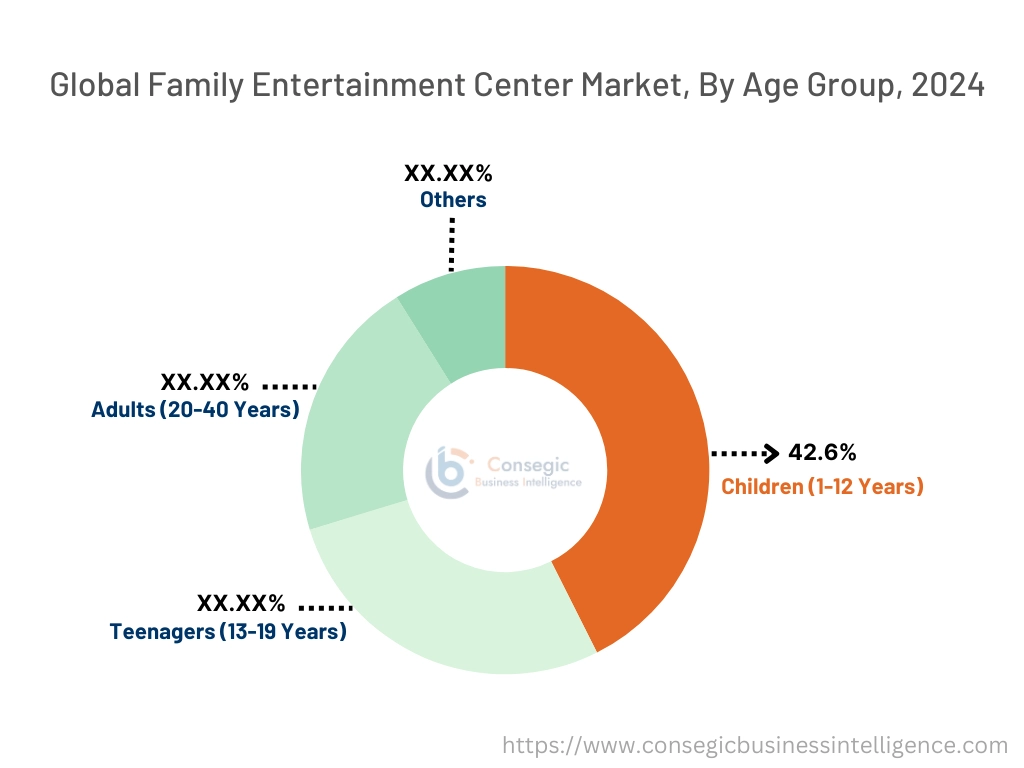
By Revenue Source:
Based on revenue source, the market is divided into entry fees & tickets, food & beverages, merchandising, advertising, and others.
The entry fees & tickets segment accounted for the largest revenue share in 2024.
- Entry fees are the primary revenue stream for family entertainment centers, driven by consistent visitor inflow.
- Flexible pricing strategies and seasonal promotions encourage repeat visits and higher spending.
- Bundled packages combining entry with gaming tokens and meal deals enhance revenue generation.
- Event hosting and special attraction passes further strengthen this segment’s market share, fueling the family entertainment center market growth.
The food & beverages segment is projected to grow at the fastest CAGR during the forecast period.
- The rising trend of combining dining with entertainment boosts the demand for diverse food and beverage offerings.
- Upscale and themed dining experiences within entertainment centers attract both families and adult visitors.
- Strategic partnerships with popular food brands and the introduction of gourmet options contribute to segment progress.
- Thus, high profit margins on food and beverages make this segment a lucrative area, further driving the family entertainment center market demand.
By Entertainment Offerings:
Based on entertainment offerings, the market is segmented into rides and attractions, games and arcades, shows and performances, dining and retail outlets, and educational and interactive exhibits.
The games and arcades segment held the largest revenue share in 2024.
- Games and arcades offer widespread appeal, catering to multiple age groups with a variety of gaming options.
- Constant technological upgrades and interactive game formats drive customer engagement and repeat visits.
- Integration of ticket redemption games and skill-based gaming enhances profitability.
- As per the family entertainment center market trends, arcade gaming remains a staple attraction in family entertainment centers, ensuring strong revenue streams.
The rides and attractions segment is expected to grow at the fastest CAGR during the forecast period.
- Innovative and immersive rides, including virtual and augmented reality attractions, are gaining popularity.
- High customer interest in unique, adrenaline-pumping experiences drives the expansion of this segment.
- Large-scale entertainment centers are increasingly investing in dynamic rides to differentiate their offerings.
- The growing demand for family-oriented rides and safe thrill experiences contributes to the segment’s growth, creating new family entertainment center market opportunities.
Regional Analysis:
The regions covered are North America, Europe, Asia Pacific, the Middle East and Africa, and Latin America.
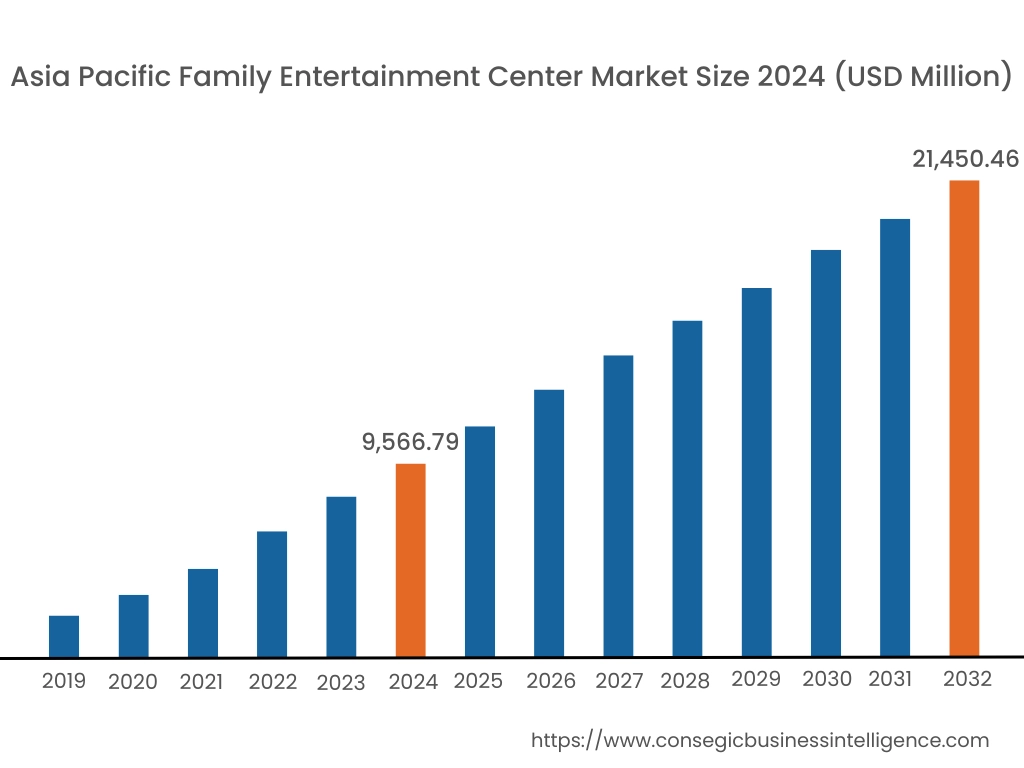
Asia Pacific region was valued at USD 9,566.79 Million in 2024. Moreover, it is projected to grow by USD 10,397.63 Million in 2025 and reach over USD 21,450.46 Million by 2032. Out of this, China accounted for the maximum revenue share of 35.3%. The Asia-Pacific region is witnessing rapid advancements in the FEC market, attributed to urbanization and a burgeoning middle class. A prominent trend is the expansion of large-scale entertainment complexes that offer a variety of attractions under one roof. Analysis indicates that the increasing popularity of shopping mall-based FECs is contributing to family entertainment center market expansion in this region.
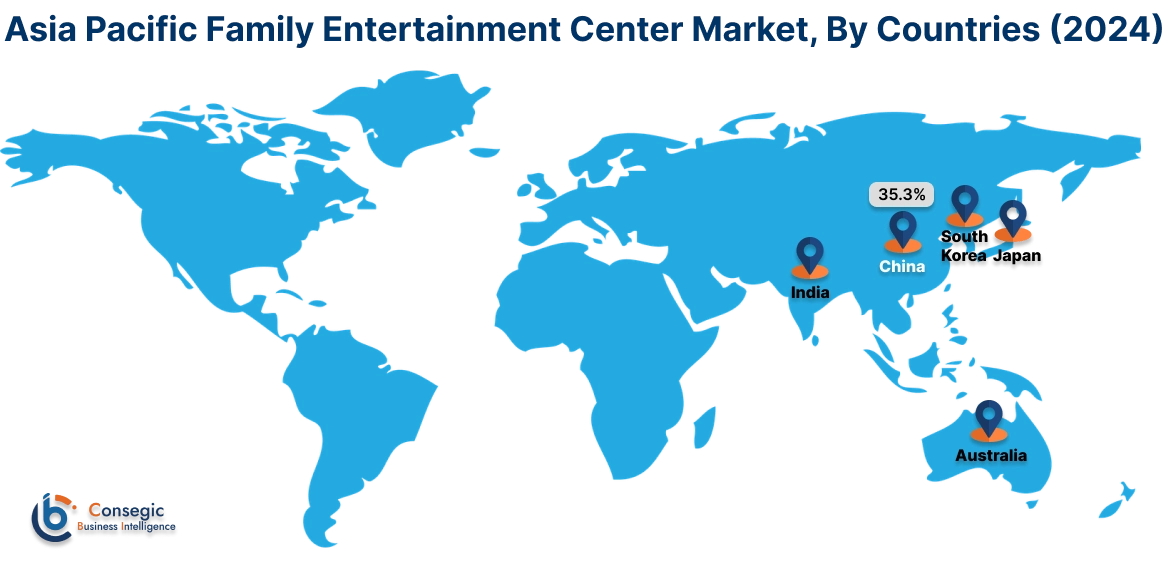
North America is estimated to reach over USD 22,831.18 Million by 2032 from a value of USD 10,775.19 Million in 2024 and is projected to grow by USD 11,655.64 Million in 2025. This region holds a significant portion of the FEC market, driven by increased disposable income and a preference for indoor entertainment options. A notable trend is the incorporation of virtual reality (VR) and augmented reality (AR) attractions to enhance visitor engagement. Analysis indicates that the emphasis on family-oriented leisure activities is propelling the market in North America.
European countries are key players in the FEC market, with a strong emphasis on integrating educational and interactive experiences. A significant trend is the development of edutainment centers that combine learning with play, catering to both children and adults. Analysis suggests that the region's focus on innovative and diverse entertainment offerings is shaping the market landscape.
In the Middle East, the FEC market is influenced by a growing focus on tourism and leisure infrastructure development. The emphasis is on creating family-friendly destinations that offer unique and culturally relevant experiences. Analysis suggests that investments in indoor entertainment facilities are pivotal in enhancing the market in these regions.
Latin American countries are increasingly recognizing the importance of FECs in providing safe and engaging environments for families. A notable trend is the incorporation of local themes and interactive attractions to appeal to regional audiences. Analysis indicates that economic development and urbanization are key factors influencing the entertainment industry in this area.
Top Key Players and Market Share Insights:
The Family Entertainment Center market is highly competitive with major players providing products and services to the national and international markets. Key players are adopting several strategies in research and development (R&D), product innovation, and end-user launches to hold a strong position in the global Family Entertainment Center market. Key players in the Family Entertainment Center industry include -
- Main Event Entertainment (USA)
- iT'Z Family Entertainment (USA)
- Time Zone Entertainment (Australia)
- Lucky Strike Entertainment (USA)
- Apex Entertainment (USA)
- Tilt Studio (USA)
- Funtopia (Bulgaria)
- Herschend Family Entertainment (USA)
- Great Wolf Resorts (USA)
Recent Industry Developments :
Service Launch:
- In December 2024, Lucky Strike Entertainment announced the grand opening of Lucky Strike Ladera Ranch in Orange County, California. This marks the 19th Lucky Strike location and the second in California, following Beverly Hills. The venue features 42 bowling lanes, an upscale bar, a gastropub menu with favorites like Firecracker Shrimp Bao Buns, and a cutting-edge arcade with 60 games.
Acquisitions & Mergers:
- In May 2024, Bowlero Corp., the world’s largest bowling center operator, has completed its acquisition of Lucky Strike Entertainment, LLC for $90 million. This deal adds 14 Lucky Strike centers across major cities like Boston, Chicago, Los Angeles, and San Francisco to Bowlero’s portfolio, expanding its footprint to 345 centers across 36 states.
Family Entertainment Center Market Report Insights :
| Report Attributes | Report Details |
| Study Timeline | 2019-2032 |
| Market Size in 2032 | USD 70,444.85 Million |
| CAGR (2025-2032) | 10.2% |
| By Facility Type |
|
| By Age Group |
|
| By Revenue Source |
|
| By Entertainment Offerings |
|
| By Region |
|
| Key Players |
|
| North America | U.S. Canada Mexico |
| Europe | U.K. Germany France Spain Italy Russia Benelux Rest of Europe |
| APAC | China South Korea Japan India Australia ASEAN Rest of Asia-Pacific |
| Middle East and Africa | GCC Turkey South Africa Rest of MEA |
| LATAM | Brazil Argentina Chile Rest of LATAM |
| Report Coverage |
|
Key Questions Answered in the Report
What is the size of the Family Entertainment Center Market? +
The Family Entertainment Center Market size is estimated to reach over USD 70,444.85 Million by 2032 from a value of USD 32,483.94 Million in 2024 and is projected to grow by USD 35,205.50 Million in 2025, growing at a CAGR of 10.2% from 2025 to 2032.
What are the key segments in the Family Entertainment Center Market? +
The market is segmented by facility type (arcade studios, children’s play areas, VR gaming zones, bowling alleys, others), age group (children, teenagers, adults, others), revenue source (entry fees & tickets, food & beverages, merchandising, advertising, others), and entertainment offerings (rides and attractions, games and arcades, shows and performances, dining and retail outlets, educational and interactive exhibits).
Which segment is expected to grow the fastest in the Family Entertainment Center Market? +
The food & beverages segment is projected to grow at the fastest CAGR during the forecast period, driven by the increasing trend of combining dining with entertainment and the rising demand for themed and upscale dining experiences.
Who are the major players in the Family Entertainment Center Market? +
Key players in the Family Entertainment Center market include Main Event Entertainment (USA), iT'Z Family Entertainment (USA), Apex Entertainment (USA), Tilt Studio (USA), Funtopia (Bulgaria), Herschend Family Entertainment (USA), Great Wolf Resorts (USA), Time Zone Entertainment (Australia), Lucky Strike Entertainment (USA).
